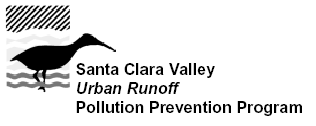Stormwater Runoff
- Vehicle Brake Pads
- Architectural Copper
- Pool/Spa/Fountain Algaecides
- Copper Pesticides
- Industrial Copper Use
- Soil Erosion
- Mobile Cleaning
- Vehicle Washing
- Vehicle Services
Discharges to POTWs
Shoreline Activities
Marine Antifouling Coatings
Within
San Francisco Bay (North of the Dumbarton Bridge), there are major ports,
industrial piers and dozens of marinas in which thousands of boats are
berthed. In addition, thousands of additional recreational boats and larger
vessels may be present within the Bay at any given time. In 2003, approximately
176,000 vessels were registered in the nine Bay Area counties. The vast
majority are pleasure boats with the remaining (a few hundred) being government
and commercial boats.
To control
unwanted fouling growth on boat and ship hulls, marine antifouling coatings
are applied. Historically, tributyltin was commonly used in marine coatings.
In the late 1980's, the United States Environmental Protection Agency
phased out the use of tributyltin-based antifoulants on recreational boats
by restricting use to ships longer than 25 meters. As a result, copper-based
biocides became the primary antifouling coating option for recreational
boats. Since copper-based biocides are present on boats and ships, it
is possible that copper may be released to San Francisco Bay.
Copper
releases from marine antifouling coatings to San Francisco Bay relates
to the amount of copper applied to boats, the number of boats, storage
location, boat use frequency, maintenance practices and other environmental
factors. In addition, all registered boats do not use antifouling coatings
and not all the copper applied to boats has the potential to be released
to the Bay. Copper releases from marine antifouling coatings may occur
by the following methods: passive leaching and in-water hull cleaning,
boat use and on-shore maintenance.
Currently,
there are no specific control measures in place to limit copper releases
from marine antifouling coatings in the San Francisco Bay area. In response
to concerns raised in developing a Total Maximum Daily Load (TMDL) for
the Shelter Island Yacht Basin in San Diego, the California Department
of Pesticide Regulation and the State Water Resources Control Board are
determining the relationship between marine antifouling coatings and copper
levels in surface waters. Potential control measures include alternative
marine antifouling coatings, hull cleaning best management practices and
prohibiting the use of copper antifouling coatings. Currently, each option
is considered to be infeasible.
Due to
the lack of San Francisco Bay specific information (e.g., number and types
of marine craft moored in the Bay, copper release rates in Bay water,
hull cleaning and recoating frequencies, use of antifouling paints, etc.),
there is a moderate to high level of uncertainty regarding copper releases.
As a result, appropriate control measures for marine antifouling coatings
can not be determined until a region-specific investigation of copper
loads is conducted.
